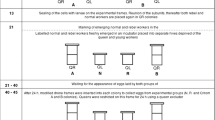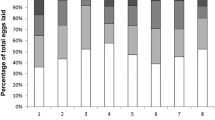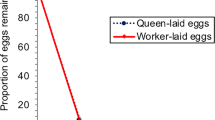Abstract
A conflict over male production arises in social insects where workers are able to lay unfertilized male eggs. This happens because each female (queen or worker) is most closely related to her own sons and is thus predicted to reproduce. The conflict is modulated by worker policing where workers prevent each other from reproducing by aggression or egg cannibalism. In this study, we show that in the ant Formica fusca, worker policing occurs by egg cannibalism rather than by overt aggression among workers. Furthermore, we show that, contrary to bees, wasps and other ant species, egg discrimination in F. fusca is not based only on a universal queen signature chemical and that nest mate recognition of eggs occurs.



Similar content being viewed by others
References
Beekman M, Ratnieks FLW (2003) Power over reproduction in social Hymenoptera. Philos Trans R Soc Lond B 358:1741–1753
Beekman M, Komdeur J, Ratnieks FLW (2003) Reproductive conflicts in social animals: who has power? Trends Ecol Evol 18:277–282
Boomsma JJ, Nielsen J, Sundström L, Oldham NJ, Petersen HC, Morgan ED (2003) Kin-assessment without kin discrimination in social insects. Proc Natl Acad Sci USA 100:8799–8804
Boulay R, Hefetz A, Soroker V, Lenoir A (2001) Camponotus fellah colony integration: worker individuality necessitates frequent hydrocarbon exchanges. Anim Behav 59:1127–1133
Boulay R, Katzav-Gozansky T, Vandermeer RK, Hefezt A (2003) Colony insularity through queen control on worker social motivation in ants. Proc R Soc Lond B 270:971–977
Bourke AFG (1988) Worker reproduction in the higher eusocial Hymenoptera. Q Rev Biol 63:291–311
Bourke AFG, Franks NR (1995) Social evolution in ants. Princeton University Press, Princeton, New Jersey
Buschinger A (1986) Evolution of social parasitism in ants. Trends Ecol Evol 1:155–160
Collingwood C (1979) The Formicidae (Hymenoptera) of Fennoscandia and Denmark. Fauna Entomol Scand 8:1–174
Crozier R, Pamilo P (1996) Evolution of social insect colonies. Oxford University Press, Oxford
Czechowski W, Radchenko A, Czechowska W (2002) The ants of Poland. Museum and Institute of Zoology PAS, Warsaw
D’Ettorre P, Mondy N, Lenoir A, Errard C (2002) Blending in with the crowd: social parasites integrate into their host colonies using a flexible chemical signature. Proc R Soc Lond B 269:1911–1918
D’Ettorre P, Heinze J, Ratnieks FLW (2004) Worker policing by egg eating in the ponerine ant Pachycondyla inversa. Proc R Soc Lond B 271:1427–1434
Endler A, Liebig J, Schmitt T, Parker JE, Jones GR, Schreier P, Hölldobler B (2004) Surface hydrocarbons of queen eggs regulate worker reproduction in a social insect. Proc Natl Acad Sci USA 101:2945–2950
Foster KR (2004) Diminishing returns in social evolution: the not-so-tragic commons. J Evol Biol 17:1058–1072
Foster KR, Ratnieks FLW (2001) Paternity, reproduction and conflict in vespine wasps: a model system for testing kin selection predictions. Behav Ecol Sociobiol 50:1–8
Frank SA (1995) Mutual policing and repression of competition in the evolution of cooperation groups. Nature 377:520–522
Frank SA (1996) Policing and group cohesion when resources vary. Anim Behav 52:1163–1169
Frank SA (1998) Foundations of social evolution. Princeton University Press, Princeton, New Jersey
Frank SA (2003) Repression of competition and the evolution of cooperation. Evolution 57:693–705
Franks NR, Ireland B, Bourke AFG (1990) Conflicts, social economics and life history strategies in ants. Behav Ecol Sociobiol 27:175–181
Gösswald K (1989) Die Waldameise. AULA-Verlag, Wiesbaden
Hamilton WD (1964) The genetical evolution of social behaviour I and II. J Theor Biol 7:1–16, 17–52
Hannonen M, Sundström L (2003) Worker nepotism among polygynous ants. Nature 42:921
Hannonen M, Sledge MF, Turillazzi S, Sundström L (2002) Queen reproduction, chemical signalling and worker behaviour in polygyne colonies of the ant Formica fusca. Anim Behav 64:477–485
Hannonen M, Helanterä H, Sundström L (2004) Habitat age, breeding system and kinship in the ant Formica fusca. Mol Ecol 13:1579–1588
Helanterä H (2004) Kinship and conflicts over male production in Formica ants. PhD thesis, University of Helsinki
Helanterä H, Sundström L (2005) Worker reproduction in the ant Formica fusca. J Evol Biol 18:162–171
Härtel S, Neumann P, Raassen FS, Moritz RFA, Hepburn HR (2006) Social parasitism by Cape honeybee workers in colonies of their own subspecies (Apis mellifera capensis Esch.). Insectes Soc 53:183–193
Iwanishi S, Hasegawa E, Ohkawara K (2003) Worker oviposition and policing behaviour in the myrmicine ant Aphaenogaster smythiesi japonica Forel. Anim Behav 66:513–519
Johnson CA, Vander Meer RK, Lavine B (2001) Changes in the cuticular hydrocarbon patterns of the slave-maker queen, Polyergus breviceps after killing a Formica host queen. J Chem Ecol 27:1787–1804
Keller L (ed) (1999) Levels of selection in evolution. Princeton University Press, Princeton, New Jersey
Landolt PJ, Akre RD, Greene A (1977) Effects of colony division on Vespula atropilosa (Sladen) (Hymenoptera: Vespidae). J Kans Entomol Soc 50:135–147
Le Moli F, Mori A (1986) The aggression test as a possible taxonomic tool in the Formica rufa group. Aggress Behav 12:93–102
Le Moli F, Parmigiani S (1981) Laboratory and field observations of attack by the red wood ant Formica lugubris Zett on Formica cunicularia Latr (Hymenoptera: Formicidae). Aggress Behav 7:341–350
Lenoir A, Cuisset D, Hefetz A (2001) Effect of social isolation on hydrocarbon pattern and nestmate recognition in the ant Aphaenogaster senilis (Hymenoptera, Formicidae). Insectes Soc 48:101–109
Liebig J, Peeters C, Hölldobler B (1999) Worker policing limits the number of dominants in a ponerine ant. Proc R Soc Lond B 266:1865–1870
Liebig J, Peeters C, Oldham NJ, Markstädter C, Hölldobler B (2000) Are variations in cuticular hydrocarbons of queens and workers a reliable signal of fertility in the ant Harpegnathos saltator? Proc Natl Acad Sci USA 97:4124–4131
Liu ZB, Yamane S, Wang QC, Yamamoto H (2001) Nestmate recognition and temporal modulation in the patterns of cuticular hydrocarbons in natural colonies of Japanese carpenter ant Camponotus japonicus (Hymenoptera, Formicidae). J Ethol 16:57–65
Lopez-Vaamonde C, Koning JW, Brown RM, Jordan WC, Bourke AFG (2004) Social parasitism by male-producing reproductive workers in a eusocial insect. Nature 430:557–560
Martin SJ, Beekman M, Wossler TC, Ratnieks FLW (2002) Parasitic Cape honeybee workers, Apis mellifera capensis, evade policing. Nature 415:163–165
Maynard-Smith J, Szathmary E (1995) The major transitions in evolution. Oxford University Press, Oxford
Miller DG, Ratnieks FLW (2001) The timing of worker reproduction and breakdown of policing behaviour in queenless honey bee (Apis mellifera L) societies. Insectes Soc 48:178–184
Monnin T, Peeters C (1999) Dominance hierarchy and reproductive conflicts among subordinates in a monogynous queenless ant. Behav Ecol 10:323–332
Monnin T, Ratnieks FLW (2001) Policing in queenless ponerine ants. Behav Ecol Sociobiol 50:97–108
Pirk CWW, Neumann P, Ratnieks FLW (2003) Cape honeybees, Apis mellifera capensis, police worker-laid eggs despite the absence of relatedness benefits. Behav Ecol 14:347–352
Ratnieks FLW (1988) Reproductive harmony via mutual policing by workers in eusocial Hymenoptera. Am Nat 132:217–236
Ratnieks FLW (1995) Evidence for a queen-produced egg-marking pheromone and its use in worker policing in the honey-bee. J Apic Res 34:31–37
Ratnieks FLW, Visscher PK (1989) Worker policing in the honeybee. Nature 342:796–797
Ratnieks FLW, Wenseleers T (2005) Policing in insect societies. Science 307:54–56
Ratnieks FLW, Foster KR, Wenseleers T (2006) Conflict resolution in insect societies. Annu Rev Entomol 51:581–608
Savolainen R (1990) Colony success of the submissive ant Formica fusca within territories of the dominant Formica polyctena. Ecol Entomol 15:79–85
Sundström L, Boomsma JJ (2001) Conflicts and alliances in insect families. Heredity 86:515–521
Trivers RL, Hare H (1976) Haploidiploidy and the evolution of social insects. Science 191:249–263
Vander Meer RK, Alonso LE (2002) Queen primer pheromone affects conspecific fire ant (Solenopsis invicta) aggression. Behav Ecol Sociobiol 51:122–130
Vienne V, Errard C, Lenoir A (1998) Influence of the queen on worker behaviour in ants. Ethology 104:431–446
Visscher PK, Dukas R (1995) Honey bees recognize development of nestmates’ ovaries. Anim Behav 49:542–544
Wenseleers T, Hart A, Helanterä H, Ratnieks FLW (2004) Worker reproduction and policing in insect societies: an ESS analysis. J Evol Biol 17:1035–1047
Woyciechowski M, Lomnicki A (1987) Multiple mating of queens and the sterility of workers among eusocial Hymenoptera. J Theor Biol 128:317–327
Acknowledgement
We thank the anonymous referees of a previous version of the manuscript for constructive comments. The work was funded by The Academy of Finland (grants number 42725, 206505 and 213821), the Graduate School for Evolutionary Ecology and the Finnish Cultural Foundation. The experiments comply with the current laws of the country in which they were performed.
Author information
Authors and Affiliations
Corresponding author
Additional information
Communicated by L. Keller
Rights and permissions
About this article
Cite this article
Helanterä, H., Sundström, L. Worker policing and nest mate recognition in the ant Formica fusca . Behav Ecol Sociobiol 61, 1143–1149 (2007). https://doi.org/10.1007/s00265-006-0327-5
Received:
Revised:
Accepted:
Published:
Issue Date:
DOI: https://doi.org/10.1007/s00265-006-0327-5




